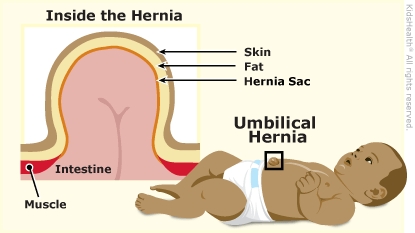Umbilical Hernias
What Is an Umbilical Hernia?
An umbilical hernia happens when part of a child's intestines bulges through the abdominal wall inside the belly button. It shows up as a bump under the belly button. The hernia isn't painful and most don't cause any problems.
Most umbilical (um-BILL-ih-kul) hernias close on their own by the time the child turns 4 or 5. If a hernia doesn't go away by then or causes problems, doctors may recommend surgery.
What Causes Umbilical Hernias?
A hernia is when part of the intestine bulges through the muscle wall that's supposed to hold it in place. With an umbilical hernia, the opening is in the middle of the belly button, at a part of the abdominal wall called the umbilical ring.
The umbilical ring is a muscle that surrounds the belly button. During pregnancy, the umbilical cord flows through the umbilical ring to bring blood and nutrients to the developing baby. The umbilical ring should close shortly after birth. If it doesn't close correctly, the intestines can poke through. This can cause a bulge near the belly button, especially when the baby cries, coughs, or strains.

Who Gets Umbilical Hernias?
Umbilical hernias are most common in newborns and infants younger than 6 months old. About 20% of babies have one. But older kids and adults can get them too.
What Are the Signs & Symptoms of an Umbilical Hernia?
The main sign of an umbilical hernia is a visible bump under the skin by the belly button.
The hernia can look bigger and smaller:
- It can look bigger when a child does something that creates pressure in the belly, like standing up, crying, coughing, or straining to poop.
- It can look smaller again when the child lies down and is calm.
How Are Umbilical Hernias Diagnosed?
Doctors diagnose an umbilical hernia by looking for a bump or swelling in the belly button area. The bump usually will get bigger when the baby cries and get smaller or go away when the baby relaxes or rests on the back.
The doctor may gently try to massage the hernia back into its proper place in the abdomen (called a reduction). A hernia that can be massaged back into place is called a "reducible" hernia. This shows that the intestine isn't stuck ("incarcerated") in the muscle wall opening.
How Are Umbilical Hernias Treated?
Most umbilical hernias are nothing to worry about, and go away without medical treatment by the time a child is 4–5 years old. Surgery is done only if:
- The hernia doesn't close by age 4 or 5.
- The hernia becomes incarcerated (can't be easily reduced).
To operate, doctors will:
- Give anesthesia so the child sleeps through the procedure and won't feel any pain.
- Make a small incision (cut) in the skin.
- Move the hernia back where it belongs.
- Close the hole or weak spot in the muscle with stitches.
- Close the incision with absorbable sutures under the skin and tape strips. These will fall off on their own in 7–10 days.
Kids sometimes need emergency surgery if the intestine is not reducible.
At home, you can push the hernia back in, but don't put tape or anything else on the hernia to hold it in. This won't make it go away, and may cause problems like infection.
When Should I Call the Doctor?
Umbilical hernias usually close on their own without surgery. Keep an eye on the hernia to see if it changes. Call the doctor if your child still has the hernia after turning 5 years old.
And call right away if:
- The hernia gets larger, seems swollen, or is hard.
- The hernia sticks out when your child is sleeping, calm, or lying down and you can't push it back in.
- Your child is very cranky or seems to be in pain.
- Your child has pain when you touch the hernia.
- The skin over the hernia is red or looks darker than usual.

© 1995- The Nemours Foundation. KidsHealth® is a registered trademark of The Nemours Foundation. All rights reserved.
Images sourced by The Nemours Foundation and Getty Images.













